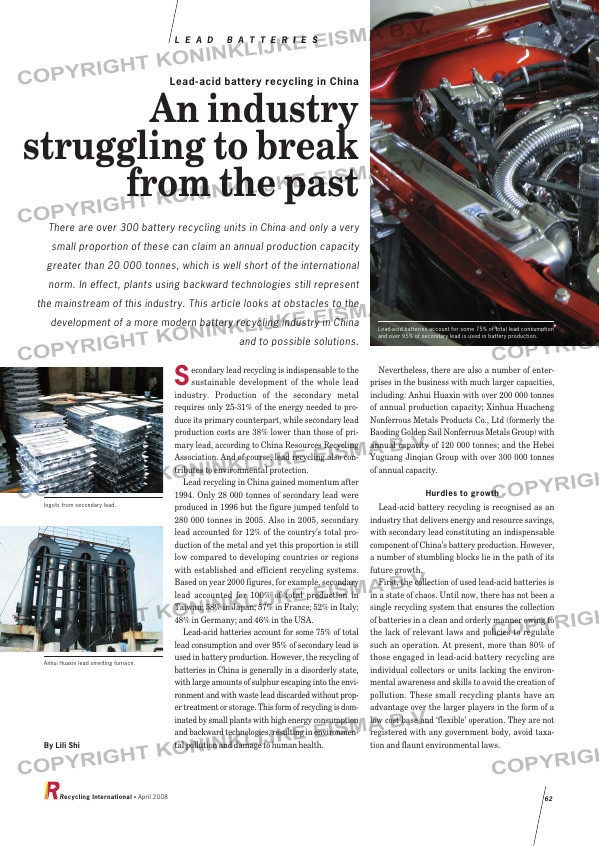Page 62 from: April 2008

S econdary lead recycling is indispensable to thesustainable development of the whole lead
industry. Production of the secondary metal
requires only 25-31% of the energy needed to pro-
duce its primary counterpart, while secondary lead
production costs are 38% lower than those of pri-
mary lead, according to China Resources Recycling
Association. And of course, lead recycling also con-
tributes to environmental protection.
Lead recycling in China gained momentum after
1994. Only 28 000 tonnes of secondary lead were
produced in 1996 but the figure jumped tenfold to
280 000 tonnes in 2005. Also in 2005, secondary
lead accounted for 12% of the country’s total pro-
duction of the metal and yet this proportion is still
low compared to developing countries or regions
with established and efficient recycling systems.
Based on year 2000 figures, for example, secondary
lead accounted for 100% of total production in
Taiwan; 58% in Japan; 57% in France; 52% in Italy;
48% in Germany; and 46% in the USA.
Lead-acid batteries account for some 75% of total
lead consumption and over 95% of secondary lead is
used in battery production. However, the recycling of
batteries in China is generally in a disorderly state,
with large amounts of sulphur escaping into the envi-
ronment and with waste lead discarded without prop-
er treatment or storage. This form of recycling is dom-
inated by small plants with high energy consumption
and backward technologies, resulting in environmen-
tal pollution and damage to human health.
Nevertheless, there are also a number of enter-
prises in the business with much larger capacities,
including: Anhui Huaxin with over 200 000 tonnes
of annual production capacity; Xinhua Huacheng
Nonferrous Metals Products Co., Ltd (formerly the
Baoding Golden Sail Nonferrous Metals Group) with
annual capacity of 120 000 tonnes; and the Hebei
Yuguang Jinqian Group with over 300 000 tonnes
of annual capacity.
Hurdles to growth
Lead-acid battery recycling is recognised as an
industry that delivers energy and resource savings,
with secondary lead constituting an indispensable
component of China’s battery production. However,
a number of stumbling blocks lie in the path of its
future growth.
First, the collection of used lead-acid batteries is
in a state of chaos. Until now, there has not been a
single recycling system that ensures the collection
of batteries in a clean and orderly manner owing to
the lack of relevant laws and policies to regulate
such an operation. At present, more than 80% of
those engaged in lead-acid battery recycling are
individual collectors or units lacking the environ-
mental awareness and skills to avoid the creation of
pollution. These small recycling plants have an
advantage over the larger players in the form of a
low cost base and ‘flexible’ operation. They are not
registered with any government body, avoid taxa-
tion and flaunt environmental laws.
L E A D B A T T E R I E S
Recycling International • April 2008 62
There are over 300 battery recycling units in China and only a very
small proportion of these can claim an annual production capacity
greater than 20 000 tonnes, which is well short of the international
norm. In effect, plants using backward technologies still represent
the mainstream of this industry. This article looks at obstacles to the
development of a more modern battery recycling industry in China
and to possible solutions.
By Lili Shi
Lead-acid battery recycling in China
An industry
struggling to break
from the past
Lead-acid batteries account for some 75% of total lead consumption
and over 95% of secondary lead is used in battery production.
Ingots from secondary lead.
Anhui Huaxin lead smelting furnace.
RI_010 Lead batteries:Opmaak 1 03-04-2008 15:04 Pagina 62



